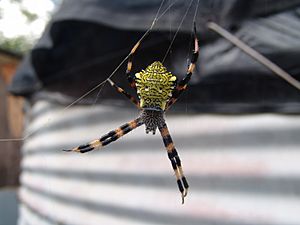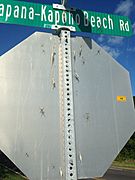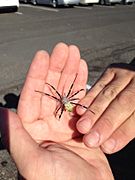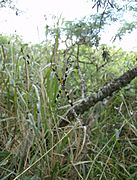Argiope appensa facts for kids
Quick facts for kids Argiope appensa |
|
|---|---|
 |
|
| On Hawai'i | |
| Scientific classification | |
| Synonyms | |
|
Argiope appensa is a type of spider known for building orb-shaped webs. It belongs to a family of spiders called Araneidae.
Where these spiders live
These spiders are found on many islands in the western Pacific Ocean. You can see them in Hawaii, Taiwan, Australia, New Caledonia, New Guinea, and Indonesia.
They were brought to all the main islands of Hawaii. They live in many different places, from beaches to forests in the mountains. During the rainy season, from June to November, you can often find them in sunny areas. These include places like roadsides and farms.
What they look like
Argiope appensa spiders show a clear difference between males and females. This is called sexual dimorphism. The females are striking with their black and yellow colors. They can be about 2 to 2.5 inches (5 to 6.4 cm) long, including their legs. The males are brown and much smaller, only about 0.75 inches (1.9 cm) long.
In Hawaii, people often call them Hawaiian garden spiders. These spiders are known to live close together. You might see many generations of them sharing the same anchor lines for their separate webs.
On Guam, where Argiope appensa spiders are very common, another spider often visits them. This spider, Argyrodes argentatus, sometimes steals food from the Argiope appensa. Locals on Guam call them banana spiders. After the brown tree snake was introduced to Guam, many small birds on the island disappeared. With fewer birds around, there were also fewer animals to eat spiders or compete with them for food. Because of this, the number of spiders on Guam grew a lot.
How they live
Argiope appensa spiders mainly build their webs in bushes and between tree branches. They also build them on human-made structures. Their webs are quite large. They have a white zig-zag silk pattern that goes from one corner to the center of the web. These patterns are called stabilimenta. Scientists think these decorations might warn birds to avoid flying into and destroying the web.
Gallery
-
Mature female being handled in Hilo, Hawaii
See also
 In Spanish: Argiope appensa para niños
In Spanish: Argiope appensa para niños






